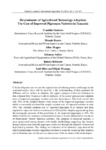Determinants of Agricultural Technology Adoption: The Case of Improved Pigeonpea Varieties in Tanzania

View/
Date
2011Author
Simtowe, Franklin
Kassie, Menale
Diagne, Aliou
Asfaw, Solomon
Shiferaw, Bekele
Silim, Said
Muange, Elijah
Metadata
Show full item recordAbstract
If dryland legumes are to meet the expectations of reducing poverty and hunger in the
semi-arid tropics, there will be need for a full understanding of their potential for
diffusion and the barriers to adoption. We apply a program evaluation technique to
data obtained from Tanzania to derive estimates of the actual and potential adoption
rates of improved pigeonpea varieties and their determinants. The study reveals that
only 33% of the sampled farmers were aware of the improved pigeonpea varieties
which consequently restricted the sample adoption rate of improved varieties to only
19%. The potential adoption rate of improved pigeonpea if all farmers had been
exposed to improved varieties is estimated at 62% and the adoption gap resulting from
the incomplete exposure of the population to the improved pigeonpea is 43%. We
further find that the awareness of improved varieties is mainly influenced by attendance
of Participatory Variety Selection activities. The adoption of improved varieties is
more pronounced among farmers with smaller landholdings suggesting that farmers
facing land pressure intensify pigeonpea production through the adoption of improved
high yielding varieties. The findings are indicative of the relatively large demand for
improved pigeonpea varieties suggesting that there is scope for increasing their adoption
rate in Tanzania once the farmers are made aware of the existence of the technologies.
